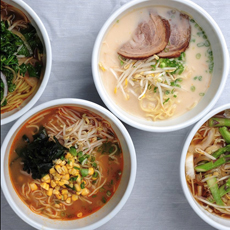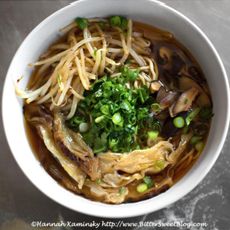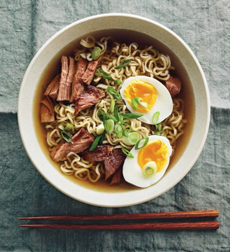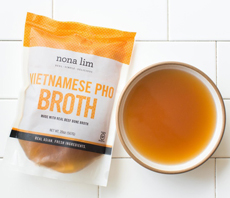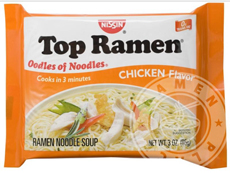Quick Homemade Ramen Soup Recipe & The History of Ramen
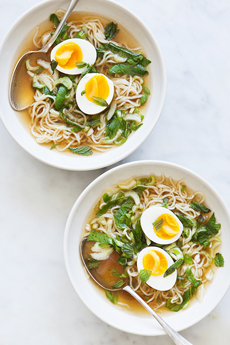 [1] This comfort food is ready in just 10 minutes with this recipe (photo © Good Eggs).
|
America’s favorite soup is chicken noodle. Is that why so many people love ramen soup, the Japanese noodle version? (Ramen is the name of the Chinese-style wheat noodles in the soup.) Both versions are comfort food and hearty main courses. Instant ramen soup is helpful in a pinch, but it’s laden with so much salt. There’s much more salt in the little silver seasoning packets than is good for you. One label we checked had 1,434mg of sodium which is 60% of your Daily Value of salt; and if you eat the whole package (two servings), you’ve exceeded your Daily Value. So here’s an easy solution: Make your own ramen soup. It’s easy, and you can make as large a batch as you like. It’s also a great catch-all for leftover pasta, meats, and veggies. Just follow this recipe template: Choose Your Base Buy beef, chicken, or vegetable broth or stock, preferably low sodium. If you like to make your own stock, by all means, use it. If you find yourself with pork bones, make pork stock. > April 4th is National Ramen Day. > July 11 is Japanese National Ramen Day. > There are more ramen recipes below. > The history of ramen noodles. > The history of noodles. Ingredients For 2-3 Servings This recipe specifies green onions and soft boiled eggs, but you can switch them out or add other toppings. Look in the fridge, look in the cupboards. 1. HEAT the broth, adding 1 cup water to dilute slightly. When it boils, add the noodles and cook for 2-3 minutes. Then add the greens and scallions and simmer for another 3-5 minutes, until greens are bright and tender but still have texture. 2. BOIL a small pot of water, then add the eggs and simmer for 7 minutes and 20 seconds. Remove from the water and place in an ice bath; peel when cold. 3. LADLE out bowls of noodles and broth. Halve the eggs and add two halves to each bowl. Top with a handful of fresh herbs and serve. We were heartbroken when our beloved pho soup starters—beer, chicken, and vegetable—were discontinued by Pacific Natural Foods. Thank goodness Nona Lim stepped in to create fine Asian broths (and soup cups, too). |
|
|
Beyond fabulous flavor, Nona, a former professional athlete who ate whole, clean foods to gain a competitive advantage; she discovered the power of food as functional medicine. She observed how inflammatory foods would hurt my performance: my body and brain would only function at peak performance or recover faster when fueled with whole, clean foods. She developed the line as a healing, nutrient-dense, non-inflammatory meal program made with fresh, plant-rich, whole food ingredients and clean preparations made from scratch. We’re happy to be eating food that is all of these things; and even happier that the flavors are fabulous. Check out the website and find the retailer nearest to you. Although we think of it as Japanese, ramen soup is a dish of Chinese wheat noodles in meat broth—chicken or pork—with toppings that originated in China. It is believed that “ramen” is the Japanese pronunciation of the Chinese word lamian, meaning “hand-pulled noodles” (as opposed to noodles that are sliced with a knife). It differs from native Japanese noodle soup dishes, in that until ramen appeared, Japanese broth was based on either vegetables or seafood (and these broths continue to be used as a base for ramen soup). While some ramen dishes began to appear in Japan in the late 1600s, they didn’t become widespread until the Meiji Era (1868 through 1912), when Japan moved from being an isolated feudal society to a modern nation. Foreign relations and the introduction of meat-based American and European cuisines led to increased production of meat, and played a large role in the growing popularity of ramen. The growth of ramen dishes continued after World War II, but remained a special-occasion meal that required going out to a restaurant. The broth could take days of simmering, requiring time beyond what most housewives could spare. Restaurant ramen is considered fine cuisine; soup recipes and methods of preparation are closely-guarded secrets. Almost every locality or prefecture in Japan created its own variation of the dish, served at restaurants (the different types of ramen by region). |
||
|
Beyond regional variations, innovative Japanese chefs continue to push the boundaries of ramen cuisine. Innovation is the name of the game. Curry ramen, invented in the Hokkaido region, became a national favorite, as has ramen based on the Chinese dish of shrimp in chili sauce. Non-Japanese ingredients such as black pepper and butter have also found their way into recipes. What’s next is anyone’s guess—or what your creative thinking adds to the bowl. (BLT? Jalapeño?) Instant Ramen In 1958, instant noodles† were invented by Momofuku Ando, founder, and chairman of Nissin Foods. Named the greatest Japanese invention of the 20th century in a Japanese poll, instant ramen allowed anyone to make this dish simply by adding boiling water. Of course, the instant version is a pale shadow of laboriously-made restaurant ramen soup. But exported, Ando’s ramen soup packages soon became a pop culture sensation across the globe. Cheap, flavorful, and filling, they were salvation to people with limited funds, including college students. To avoid the sodium overload, toss the seasoning packet and add your own seasonings: red pepper flakes, curry, herbs, whatever. Instead of salt, use low sodium soy sauce. *Japanese 7 Spice, shichimi togarashi, is a popular seasoning for soup, rice and other dishes. It’s a blend of black and/or white sesame seeds, dried nori seaweed, hot red pepper, ginger, orange peel, and other ingredients such as hemp seed, poppyseed, and white pepper. You can blend your own or buy it. †The first instant noodles were ramen, but now include soba, udon, etc. |
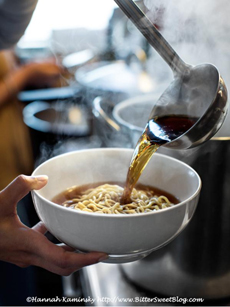 [6] Restaurant ramen soup, simmered for many hours to get an elegant broth (photo © Hannah Kaminsky).
|
|
|
CHECK OUT WHAT’S HAPPENING ON OUR HOME PAGE, THENIBBLE.COM.
|
||
